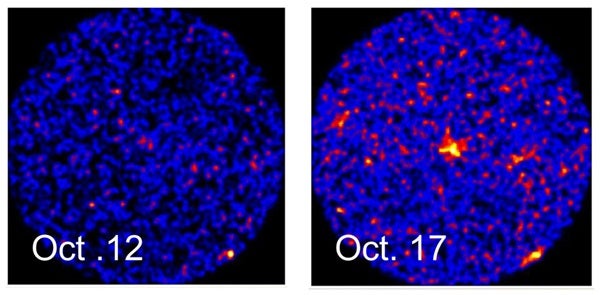The binary system was revealed recently when an instrument on the ISS, named Monitor of All-Sky X-ray Image (MAXI), on the Exposed Facility of the Japanese Experiment Module “Kibo” caught it in the act of erupting with a massive blast of X-rays known as an X-ray nova. The MAXI mission team quickly alerted astronomers worldwide to the discovery of the new X-ray source at 2:00 a.m. EDT October 20, and NASA’s Swift Observatory quickly conducted an urgent “target-of-opportunity” observation 9 hours later, which allowed for the location of the X-ray nova to be measured accurately.
“The collaboration between the MAXI and Swift teams allowed us to quickly and accurately identify this new object,” said Jamie Kennea from Penn State University. “MAXI and Swift’s abilities are uniquely complementary, and, in this case, have provided a discovery that would not have been possible without combining the knowledge obtained from both.”
The Swift detection confirmed the presence of the previously unknown bright X-ray source, which was named MAXI J1409-619. “The Swift observation suggests that this source is probably a neutron star or a black hole with a massive companion star located at a distance of a few tens of thousands of light-years from Earth in the Milky Way,” said David Burrows from Penn State. “The contribution of Swift’s X-ray Telescope to this discovery is that it can swing into position rapidly to focus on a particular point in the sky, and it can image the sky with high sensitivity and high spatial resolution.”
“MAXI has demonstrated its capability to discover X-ray novae at great distances,” said Kazutaka Yamaoka from Aoyama Gakuin University in Japan. “The MAXI team is planning further coordinated observations with NASA satellites to reveal the identity of this source.”
The binary system was revealed recently when an instrument on the ISS, named Monitor of All-Sky X-ray Image (MAXI), on the Exposed Facility of the Japanese Experiment Module “Kibo” caught it in the act of erupting with a massive blast of X-rays known as an X-ray nova. The MAXI mission team quickly alerted astronomers worldwide to the discovery of the new X-ray source at 2:00 a.m. EDT October 20, and NASA’s Swift Observatory quickly conducted an urgent “target-of-opportunity” observation 9 hours later, which allowed for the location of the X-ray nova to be measured accurately.
“The collaboration between the MAXI and Swift teams allowed us to quickly and accurately identify this new object,” said Jamie Kennea from Penn State University. “MAXI and Swift’s abilities are uniquely complementary, and, in this case, have provided a discovery that would not have been possible without combining the knowledge obtained from both.”
The Swift detection confirmed the presence of the previously unknown bright X-ray source, which was named MAXI J1409-619. “The Swift observation suggests that this source is probably a neutron star or a black hole with a massive companion star located at a distance of a few tens of thousands of light-years from Earth in the Milky Way,” said David Burrows from Penn State. “The contribution of Swift’s X-ray Telescope to this discovery is that it can swing into position rapidly to focus on a particular point in the sky, and it can image the sky with high sensitivity and high spatial resolution.”
“MAXI has demonstrated its capability to discover X-ray novae at great distances,” said Kazutaka Yamaoka from Aoyama Gakuin University in Japan. “The MAXI team is planning further coordinated observations with NASA satellites to reveal the identity of this source.”










